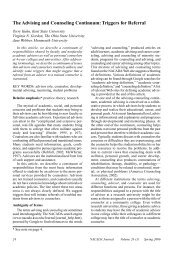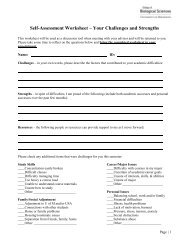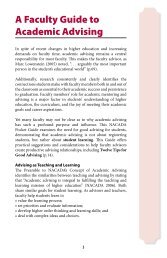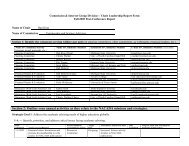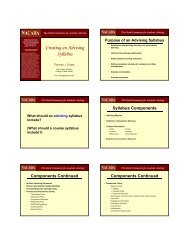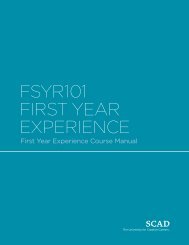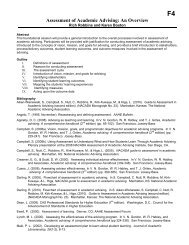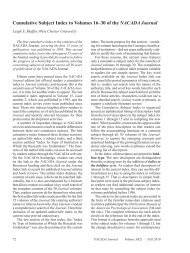An Academic Advising Model - NACADA
An Academic Advising Model - NACADA
An Academic Advising Model - NACADA
You also want an ePaper? Increase the reach of your titles
YUMPU automatically turns print PDFs into web optimized ePapers that Google loves.
<strong>An</strong> <strong>Academic</strong> <strong>Advising</strong> <strong>Model</strong>This classic article, upon which many of the subsequentarticles reflect, originally appeared in 1972 inthe Junior College Journal (volume 42, pp. 62, 64,€9 66-69) and is reprinted with bolh permission anddeep appreciation.The purpose of academic advising is to helpthe student choose a program of study whichwill serve him in the development of his totalpotential. As such, academic advising is a centraland important activity in the process of education.<strong>Academic</strong> advising occurs at least onceeach term for every student in the college; fewstudent personnel functions occur as often oraffect so many students. But while there is generalagreement concerning the importance ofacademic advising for the efficient functioningof the institution and the effective functioningof the student, there is little agreement regardingthe nature of academic advising and whoshould perform the function.The community college, as with many of itseducational practices, has too eagerly adoptedan academic advising model practiced in fouryearcolleges and universities. In that model, academicadvising has been "faculty advising" with"every faculty member an advisor." When thequestion was raised regarding the appropriatenessof this model for the community collegein a discussion at the 1964 Chicago conferencethat launched the Carnegie study, a leading studentpersonnel educator from a major universityreplied: "Of course this model is appropriatefor the junior college. Faculty members shoulddo the advising regardless of the institution."Many community college educators feel, however,that a different model may be more appropriatefor the community college and forcommunity college students. This articleproposes a model based on a logical sequence ofsteps to be followed in the process of academicadvising. The model, while geared to the communitycollege, would probably be adaptable tofour-year colleges and universities as well.The Process of <strong>Academic</strong> <strong>Advising</strong>What is the process of academic advising?Too often, programs have been planned on thebasis of available personnel (such as faculty) oron the basis of some philosophical rationale thathas been shoddily stated, if stated at all. Seldomhave programs been constructed and coordinatedon the basis of the process or nature of academicadvising.The process of academic advising includes thefollowing dimensions: (1) exploration of lifegoals, (2) exploration of vocational goals, (3)program choice, (4) course choice, and (5)scheduling courses.Ideally, the college would provide the studentwith a variety of experiences in each of these dimensions.The experiences would hopefullyoccur in a sequential order, as indicated. Thecollege that is dedicated to helping studentsachieve their maximum potential-and all communitycolleges subscribe to such a philosophy-willprovide students with professionalpersonnel who can help them focus on the question:"How do I want to live my life?" Few studentshave had opportunities to explore thisquestion in an intensive and meaningful way;college should be an experience especially designedfor such exploration. Without such anexploration, a student would not be able to decidehow to use his skills and interests in a vocation.Vocational goals are life goals extended intothe world of work. What a person is and wantsto be (life goals) determines what he does (vocationalgoals). The relationship between life goalsand vocational goals is intricate and involved;educators are understandably frustrated in theirattempts to help students make decisions inthese areas. But because it is a difficult processin education is no reason to avoid it. Many programsof academic advising flounder becausethey begin at step three with "program choice."It is assumed that students have already madechoices regarding life goals and vocational goalswhen they enter the college-a questionable assumptionfor college students in general and aharmful assumption for community college studentsin particular.To Select a ProgramOnce the college has provided an opportunityfor goal explorations through summer advisinggroups, encounter groups, occupational classes,<strong>NACADA</strong> Joz~rnal Volume 14 (2) Fall 1994
Classics Revisitedself-development classes, programmed guides,media, experiential sessions, etc., the student isready to make a prograrn choice. Even in a collegeor university offel-ing traditional "college"programs to a selected clientele, the process ofchoosing a program is difficult; in a communitycollege offering a comprehensive range of programsto a great diversity of students, the processof choosing a program staggers the imagination.Once the program is selected, students choosecourses for the immediate term and perhaps forsubsequent terms. Most colleges provide programguides which list the required courses,often noting the courses required by differenttransfer institutions. Course selection is a difficultand time-consuming process requiring extensiveknowledge on the part of the advisor regardingcourses as well as the individual beingadvised.Selecting the times courses are to be taken isoften thought to be a simple task. But manycommunity college students are confused bysuch concepts as semester-hour credit, transfer,grade point average, etc. They are often left ontheir own to figure out a schedule of classes toattend three days a week rather than the five towhich they were accustomed in high school.While the scheduling of courses may appeareasy to professional educators who themselveshave experienced scheduling time and again intheir collegiate experiences, it can be a frighteningexperience to the nontraditional college studentwho attends the community college.These five steps, then, are the dimensions ofthe process of academic advising: (1) explorationof life goals, (2) exploration of vocationalgoals, (3) program choice, (4) course choice, and(5) scheduling courses. <strong>An</strong>y well-conceived programof academic advising will include activitiesrelated to each of these dimensions. It may bepossible for each of these dimensions to be exploredin a single day; most colleges, however.are likely to consider the process of academicadvising as continuous, beginning before thestudent attends class and continuing throughouthis stay at the college.To better understand the nature of the processof academic advising it will be helpful to considerthe skills, knowledge, and attitudes requiredby the personnel who would assiststudents in each of the steps. The following is atentative listing of such requirements:1. Exploration of life goals: (a) knowledge of studentcharacteristics and development, (b) un-derstanding of decision-making process, (c)knowledge of psychology and sociology, (d)skills in counseling techniques, (e) appreciationof individual differences, (f) belief in worth anddignity of all men, (g) belief that all have potential.2. Exploration of vocational ~oals (all undernumber 1 above plus the following): (a) knowledgeof vocational fields, (b) skill in interpretation oftests, (c) understanding of changing nature ofwork in society, (d) acceptance of all fields ofwork as worthy and dignified.3. Progmm choice: (a) knowledge of programsavailable in the college, (b) knowledge of requirementsof programs (special entrance requirements,fees, time commitments), (c) knowledgeof university requirements for transferprograms, (d) knowledge of how others haveperformed in the program, (e) knowledge offollow-up success of those who have completedthe program.4. Course choice: (a) knowledge of coursesavailable. (b) knowledge of any special informationregarding courses (prerequisites, offeredonly in certain times, transferability; Does thecourse meet graduation requirements? (What isthe appropriate sequence for the university?) (c)rules and regulations of the college regardingprobation and suspension, limit on course load(academic and work limitations), (d) knowledgeof honors courses or remedial courses, (e)knowledge of instructors and their teachingstyles, (f) knowledge of student's ability throughtest scores, high school record, (g) knowledge ofcourse content.5. Scheduling courses: (a) knowledge of schedule,(b) knowledge of the systerns of schedulingand changing the schedule, (c) knowledge ofwork and commuting requit-ements.Considering the proposed five steps in theprocess of academic advising and the skills,knowledge, and attitudes required by advisorsfor each step, who should have responsibility forwhat? Contrary to those systems in which advisorsmake decisions for students, this writerbelieves that students are responsible for makingdecisions throughout the process. It is theresponsibility of the advisor to provide informationand a climate of freedom in which studentscan best make such decisions. Professionallyprepared counselors can best provide assistancefor students in the advising process for the firsttwo steps: exploration of life goals and explorationof vocational goals. Some sensitive instruc-<strong>NACADA</strong> Journal Volume 14 (2) Full 1994
Terry O'Baniontors could participate in these two steps, butcounselors should have major responsibility.Counselors can prepare materials for studentsto explore before the students ever come tocampus. Special group meetings car1 be formedin the summers to help students explore life andvocational goals. The majority of communitycollege students should enroll in special coursesin personal development, occupational exploration,value seminars, encounter groups withcounselors to allow for a more thorough andmeaningful exploration before choosing specificprograms. Regardless of the methods used, studentsshould have assistance from professionalcounselors to make decisions before they moveon to step three, program choice.Once vocational goals have become fairly specific,or at least identified as unclear, decisionsregarding choice of programs offered by thecollege become easier. As the student exploresvocational goals with a counselor, he reviews thevarious programs offered by the college and selectsa program or an area of programs that interestshim. At this point professional counselorscould continue with the advising processthrough steps three and four, or these stepscould become the responsibility of instructionalpersonnel or special personnel employed for academicadvising.When a student has selected the courses he isto take for the term, he then registers and arrangesa schedule of classes. Some colleges havemoved to computer registration, but many stilluse professional personnel to help studentsmake decisions regarding scheduling. Neithercounselors nor instructors are necessary, exceptin very special cases, to make scheduling a successfulending to the process of academic advising.A selected group of sophomores, speciallytrained, can assist other students in schedulingas well as professionals. More and more, collegeswill employ counselor-aides to assist inscheduling. Many students, of course, need noassistance in this step; some need no assistancein any of the steps.While the brief overview above indicates areasof general responsibility for academic advisingin terms of the model of the process proposed,the question still remains: "Yes, but who shoulddo academic advising?" This question cannot beanswered for individual institutions because ananswer depends on resources and personalbiases of administrators.In reality, who does advising is probably notas important as the philosophy of the institutionthat supports the academic advising programand the commitment and understanding withwhich the counselor or instructor approachesthe process.There are some factors pro and con, however,that may be helpful in deciding on which groupof professionals should have major responsibilityfor academic advising. In the following sectionthe discussion centers on who should assist studentsin steps three and four (program choiceand course choice). The writer feels, as he hasindicated, that steps one and two should be performedby professional counselors and step fiveby student assistants.The reasons that colleges give for using counselorsystems of advising are varied. One of themost usual reasons given is that the student is awhole person. The implication here is that thecollege should not fragment the student intopersonal, academic, and vocational parts by havingcounselors relate to his personal characteristicsand instructors relate to his academicand vocational characteristics. In the counseloracademic advising system the counselor assiststhe student with personal questions of life goals,helps him with decisions regarding vocationalgoals, and provides assistance with academic decisionsregarding program and course choice.A Logical SequenceRelated to the rationale that the student is awhole person is the recognition that the steps inacademic advising form a whole process. Stepsone through five form a logical sequence for individualdecision making and for institutionalprogramming. The effects of the program arebest realized if the program is organized as anintegrated sequence of events. If counselorsshould perform steps one and two by virtue oftheir competencies, then it follows that the programwill probably be better coordinated andimplemented if counselors perform steps threeand four. Step five, of course, would be coordinatedand supervised by counselors.Effective counselors have had good programsof graduate preparation in which they have becomeskilled in listening to students and helpingthem in decision making. They also know howto interpret tests, an important part of programplanning. Community college instructors whocome from traditional liberal arts or teacher educationprograms have not usually had suchpreparation. The decision-making process regardingprograms and courses is a most impor-<strong>NACADA</strong> Journal Volume 14 (2) Fall 1994
Classics Revisitedtant process, and those professionals who arebest prepared to assist in such processes shouldbe made available to students.Counselors who see only individual studentsin their private cubicles come into contact with avery small proportion of the student body. It isoften argued that in counselor advising systemscounselors are forced to relate with more students.Some administrators use this rationale tolaunch a counselor advising system because theyknow the value of counselor-student interrelationships,and they wish to make such relationshipsavailable to a greater number of students.In colleges where counselors are alreadyworking at full capacity, such a proposal, ofcourse, would need to be accompanied by a requestfor additional counseling staff.Communicating Other ServicesCounselor advising systems are often advancedon the basis that such a program willgive the staff an opportunity to communicateother student personnel services to all students.Except through the orientation program thestudent personnel staff seldom has an opportunityto communicate its services to all students.Since advising occurs each term for eachstudent, staff members can inform students regardingfinancial aid, placement, personal counseling,student activities, individual testing, andother services. The academic advising systemcan become the vehicle through which many ofthe services of the student personnel programbecome available to students. In that way, academicadvising is not simply an additional serviceto be performed requiring new staff; it canbecome the service through which most otherservices are realized.Counselors, in colleges where their expertiseis recognized and supported, do not usuallyteach subject matter courses and, therefore, aremore available to students for academic advisingconferences. When commuting and workingstudents are on campus, instructors are in class;counselors can be available during morning sessions,however, and many colleges have counselorsavailable in the evening.In addition to being available in the day andevening, counselors are also available in thesummer when the bulk of academic advisingshould occur for new freshmen. <strong>An</strong> excellentadvising progranl can be organized by counselorswho see small groups of studentsthroughout the summer. It is possible to pro-vide orientation, testing, advising, and registrationfor most new freshmen in a carefully organizedand coordinated summer program inwhich students spend no more than one or twodays on campus.In a counselor advising system, the collegeand the educational process become part of thesubject matter specialties of the counselor.Counselors must know as thoroughly as possiblethe nature of the programs and courses offeredby the college, instructors, rules and regulations,graduation and transfer requirements, divisionaland departmental requirements, tests and records,and supportive agencies in the community.Counselors are freer to become specialists inthese areas than instructors who operate primarilyfrom within a subject matter discipline.Perhaps because of this broader perspectivecounselors are less likely to recruit students tosubject matter than are instructors.There are problems, of course, with a counseloracademic advising system. One of the mostinsurmountable problems is that counselorsoften do not like or want to do academic advising.Counselors often perceive academic advisingas a time-consuming, clerical process not demandingof their professional competencies.Such perceptions are a natural outgrowth ofmost counselor education programs in whichcounseling is taught as a therapeutic process tobe made available on an individual basis only forthose with personal problems. Many counselorswant to be therapists; they have had little opportunityto realize their skills in the larger role aseducators who can have considerable impact onthe educational process. Administrators whowish to use counselors as academic advisorsshould select them carefully and should providenumerous opportunities for their reeducation.Program SpecializationIn larger colleges with extensive comprehensiveprograms it is too much to ask counselors tobecome specialists in all phases of all programs.There is too much information and it changestoo often. Some colleges assign counselors to instructionaldivisions as one way of keeping upwith size and change. While many colleges assigncounselors to divisions to do the advising inthose divisions, several colleges have actuallybuilt offices for their counselors in the divisions.<strong>An</strong>other problem with the counselor advisingsystem is that counselors can become perceivedby students and instructors as programmers<strong>NACADA</strong> Jou~.nalVolun~e 14 (2) Fall 1994
ather than counselors. If the college does notfurnish a sufficient number of counselors foracademic advising, then counselors will indeedspend too much of their time with the nitty-grittydetails of academic advising. If that happensthey become highly paid clerks whose greatercompetencies in helping students explore lifeand vocational decisions become lost in a flurryof forms and figures.The reasons given for instructor systems ofadvising are also varied. One of the reasonsmost often given is that instructors know studentsbetter than counselors. Instructors meetstudents in class and have opportunities to knowtheir interests, skills, problems, and reactionsmuch better than counselors. If the instructor isgiven a small advising load of students who arealso in his classes, he does have an opportunityto become well acquainted with students.It is also argued that the instructor is the expertin curriculum and instruction and thusknows the college best. Instructors can provide avaluable experiential background for the studentwho explores a program in which the instructoris a professional. If instructors canmove beyond the confines of their own subjectmatter disciplines, they can reflect the broaderprogram of the college. <strong>Academic</strong> advising is, ofcourse, intricately related to curriculum and instruction,and when instructors do advisingthere is greater opportunity to integrate theprocess of advising with the program of curriculumand instruction.Instructor Interaction Through <strong>Advising</strong>A number of leading educators have suggestedthat faculty advising is the best way to integrateinstructors into the student personnelprogram. The college that encourages instructorinteraction with students outside the classroomoften does so primarily through an instructoradvising system. In this way theinstructor is forced to learn more about the institutionand hopefully comes to see the studentin different ways: at least the student has an opportunityto see the instructor in a differentrole. When instructors volunteer for these outof-classactivities, they are likely to be better advisorsand better instructors. When instructorsare required to participate in academic advising,both advising and instruction may suffer.Administrators often argue in favor of facultysystems of advising-on the basis of lower costs.With the great increase in numbers of studentsin community colleges, a personalized advisingsystem can be expensive. It appears to makesense that the way to keep costs down is to distributestudents among instructors for advising.If instructors are given released time to performthis function, however, it is questionable whetherit is less expensive to use instructors in preferenceto counselors. If instructors are not givenreleased time, advising becomes for many a perfunctoryactivity.It is also argued that instructors will get theadvising job done, whereas counselors are proneto probe psyches rather than assist students inwhat is often perceived as a relatively simpleprocess of decision making. Where counselorshave communicated their program as "the psychicrepair center" students may have more confidencein instructors for the advising process.There are problems, too, with an instructoracademic advising system. Often the program ofacademic advising is poorly conceived and coordinated;instructors are left to fend for themselves.Since academic advising has been a traditionalfunction of instructors they are expectedto function adequately. Without appropriate institutionalsupport and direction, instructorsmay perform this function with disinterest andin ways that may do more harm than good forstudents.Instructors can also become too narrowlyfocused in regard to their subject matter specialization.Some instructors feel they are hiredto teach their subject; institutional efforts to getthem involved in other programs are viewed asimpositions and sometimes as even encroachmenton academic freedom.<strong>An</strong>other problem that is sometimes raised inregard to instructor advising systems is thatsome instructors use the system to recruit studentsto their classes or to classes in their departments.It is easy for an instructor to makesubtle suggestions to students regarding coursesthey should take; some instructors are not subtleat all in their "advising."Few instructors have the time necessary forin-service education designed to help them becomeeffective advisors. If they teach full loads,participate on committees, and sponsor clubsand organizations, there is little time left for inserviceeducation. Unless there is an opportunityfor instructors to learn about test interpretation,programs and courses, rules and regulations,transfer requirements, and many otheraspects of the academic advising process, theycannot be expected to perform effectively.<strong>NACADA</strong> Journal Volume 14 (2) Fall 1994
Classics RevisitedIf instructors are to participate in the processof academic advising in a professional way, thensome important conditions must exist:1. <strong>Academic</strong> advising must be recognized bythe college as an important activity in the life ofthe institution. This means that instructors arerewarded for their participation perhaps by recognitionof their contributions at the time ofevaluation for rank and pay or in reduced classloads.2. There must be a sensible student load. Inthe Carnegie report, Raines suggested thatthere be no more than 15 advisees without areduced teaching assignment.3. There must be a continuing in-service programfor all advisors, and a special, more intensiveprogram for new instructors before theyare allowed to participate.4. There must be special concern for the advisoryskills of instructors, which means thatonly those who qualify should participate.5. There must be an adequate number of professionalcounselors available to handle referralsas well as students who are undecided about lifeand vocational goals.6. There must be sufficient clerical help availableto insure that instructors have informationwhen they need it and do not perform clericaltasks themselves.7. Cooperation and coordination must existbetween the academic dean and the student personneldean to insure the best use of facultytime in the best service to students.8. Instructors must guard against using thesystem to recruit students into courses and programsnot of the students' choice.9. Finally, there must be a program of evaluationby students, instructors, and counselors inorder that sensible modification can be made ina system that is ever changing.If these conditions are met, then it seems reasonableto believe that an instructor advisingsystem can function as well as any other. If theseconditions are not met, then instructor advisingsystems will continue to be the poorly designed,grossly ineffective systems they are in far toomany community colleges.<strong>Academic</strong> <strong>Advising</strong>: A Team ApproachIf the process of academic advising proposedearlier is accepted as a viable model, then thequestion of who should perform the functionseems to be answered best in terms of a teamapproach. Each member participating in theprocess should contribute in terms of his competenciesand interests.The student is responsible for decision makingthroughout the process. He should explorethe special materials made available to him sothat he is informed about choices to be madeand about procedures. It is the student's responsibilityto schedule his own courses but with thehelp of other students specially trained for thetask. With appropriate programmed materialsstudents can also select their own courses with aminimum of supervision. The student's role inthe process will depend on his own experience,ability, and clarity of goals.In the team approach counselors should haveresponsibility for helping students explore lifeand vocational goals. Ideally, such explorationshould occur in small personal interactiongroups during the summer for new students. Aprogrammed guide designed to help studentsexplore life and vocational goals could be developedif face-to-face groups are not possible.Once students are attending college, there is stilla need to offer continuing opportunities for lifeand vocational goal exploration. Special seminarson occupations, experiential approaches tojob sampling, personal development courses,and voluntary encounter groups are only a fewof the ways the college can provide significantopportunities for students to discover meaningin their lives.In addition to this direct involvement withstudents, counselors would prepare special informationfor irlstructors and students to beused in the academic advising process. Counselorswould also provide in-service educationactivities for instructors and student assistants.The Role of the InstructorThe role of the instructor in the team approachwould be in assisting students withchoice of program and courses. Once the student'sgeneral vocational area had been decidedupon, he would meet with selected instructors toreview the various programs offered by the collegein his chosen vocational area. When a specialprogram is chosen (electronics technology,nursing, forestry, teaching), the student, withassistance from the instructor, would select thecourses for the immediate term and perhapsplan a sequence of courses for his tenure at thecommunity college.This description of roles in regard to theprocess of academic advising is, of course, great-<strong>NACADA</strong> Journal Volume 14 (2) Fall 1994
Terry O'Banionly oversimplified. Students do not always movefrom step to step in the logic of the proposedsystem. Some counselors and instructors willmove through more steps than they have responsibilityfor. Since the process is a natural sequenceof human events, there will be muchoverlap from step to step. For these reasons it ismost important that the team approach to academicadvising be carefully conceptualized andcoordinated. Under the team approach, coordinationshould be the responsibility of both thedean of students and the dean of instruction.It may be easier to organize a system of academicadvising using counselors only or instruc-tors only. Each approach has its merits and itsdifficulties. But it should also be possible tocombine the professional competencies of counselorsand instructors in such a way that the educationalplanning of students results in wellformulatedgoals and sound decisions. <strong>Academic</strong>advising occurs every term for every student;it is the prelude to the central activity of the college-instruction.Certainly the college shouldorganize its resources to insure that this preludeis sufficiently effective so that the student willhave the greatest possible opportunity to discoverhis potential through the college experience.Reprinted with permission of the Junior College Journal (now Community Coll~g~ Journal), vol. 42, no. 6,1972. For more information or a sample copy of the Community Coll~g~ Journal, please contact AACC,One Dupont Circle NW, Suite 410, Washington, DC, 20036. Phone: (202) 728-0200.<strong>NACADA</strong> Journal Volume 14 (2) Fa11 1994



